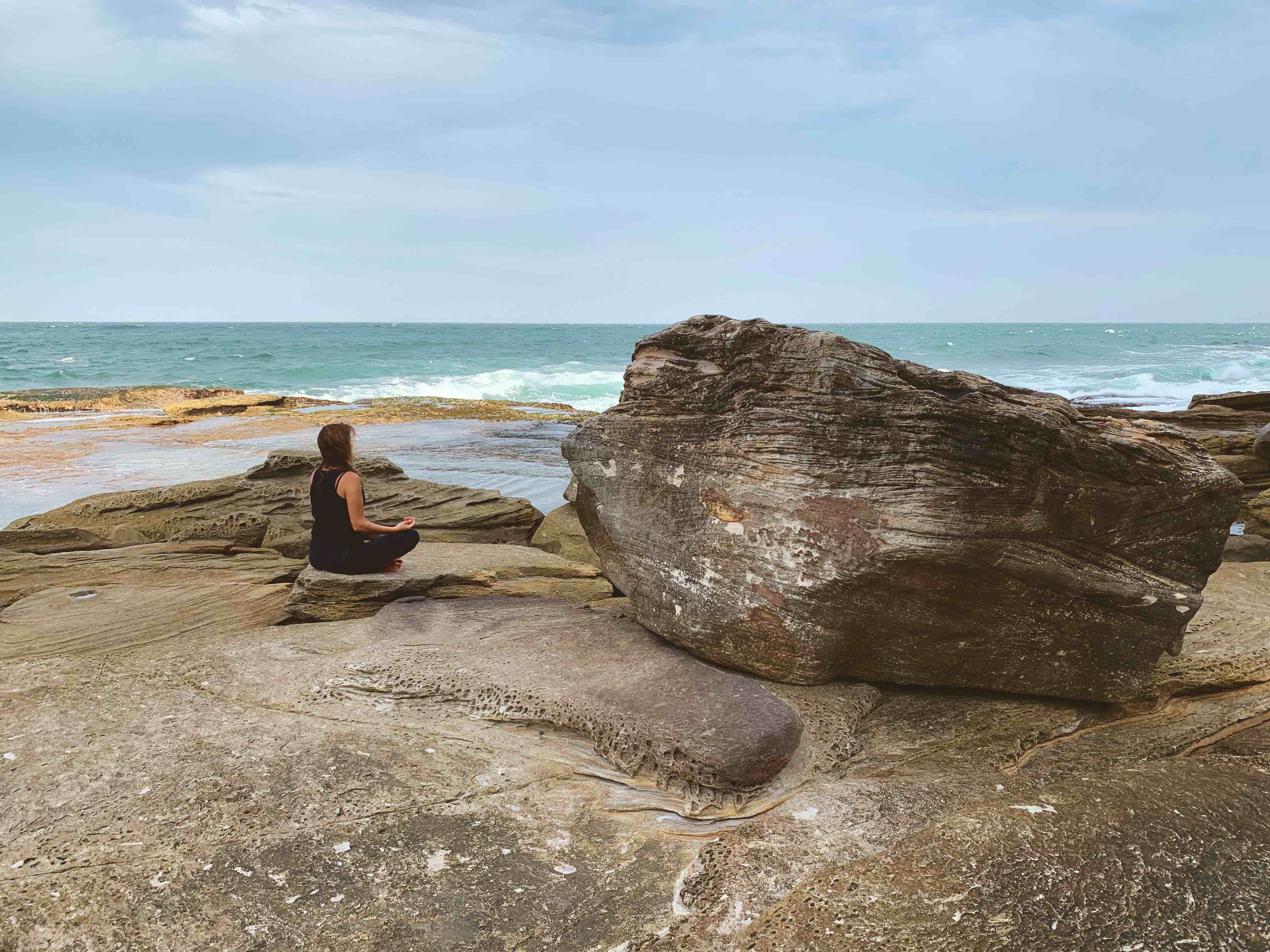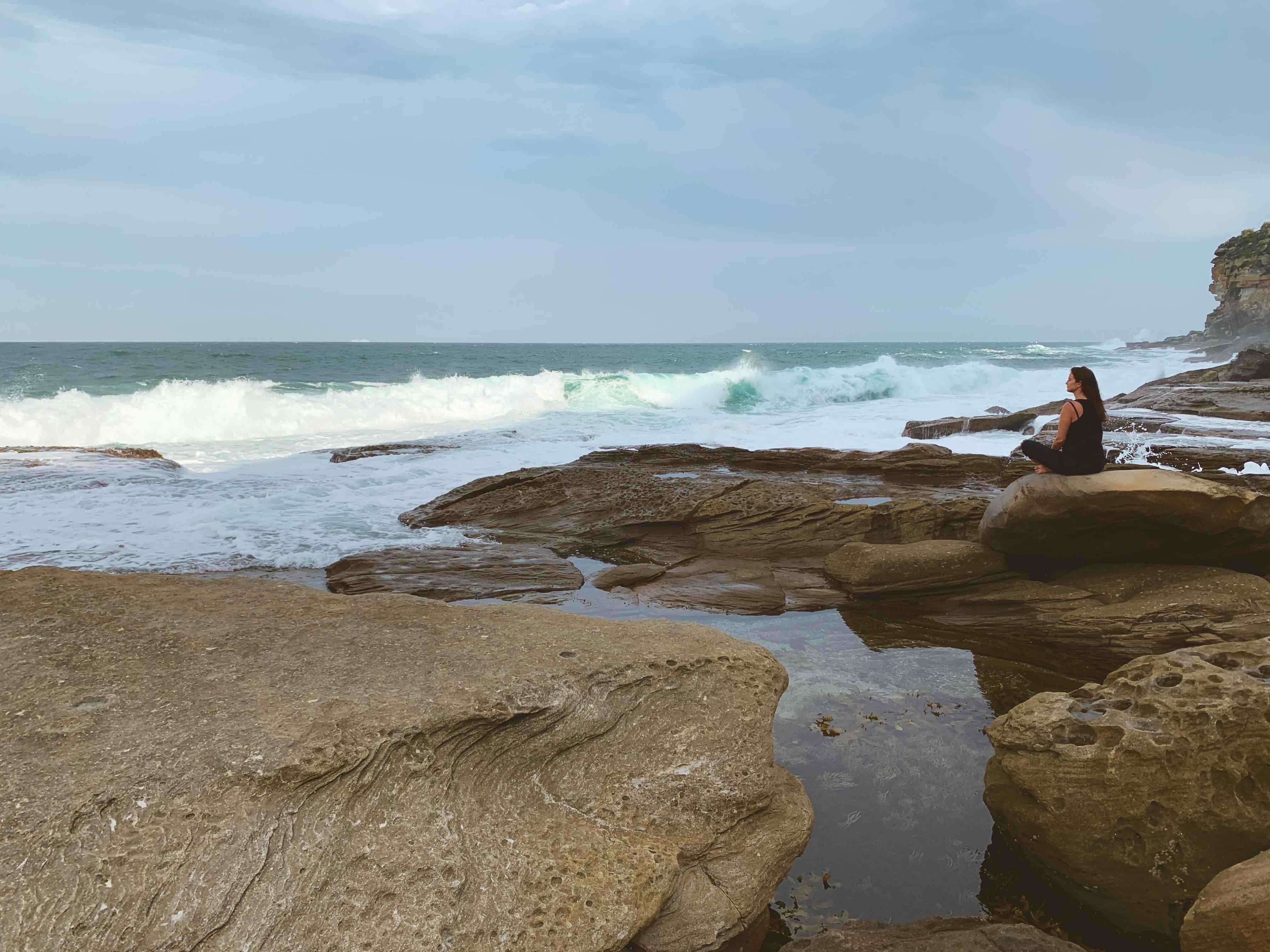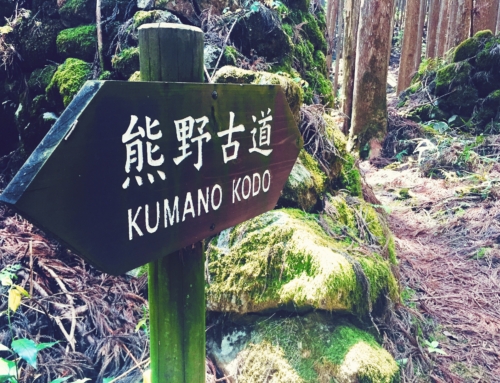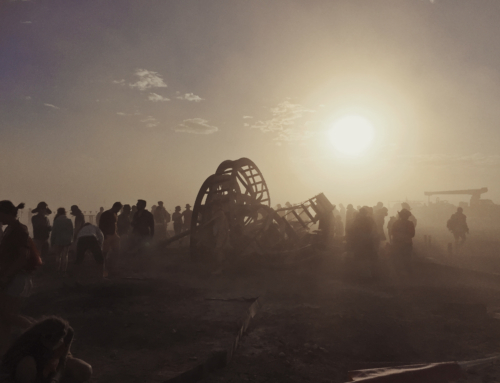When looking for a title for this post, I decided to go with “My challenging 10-day silent Vipassana Meditation Experience” instead of “… Retreat” to not to give you the wrong impression. Embarking on a 10-day Vipassana journey has little in common with a relaxing holiday where you treat yourself to massages, yoga and wellness. Spending 10 days in silence and meditating for up to 12 hours every day can be really challenging and intense – both on a physical and emotional level.
In this article, I’ll share my personal experience with you and reveal how I dealt with these challenges throughout the 10 days.
Here’s a quick overview of the various topics for easy navigation:
Rules & Guidelines
While I was looking forward to 10 days of silence, I also felt quite intimidated by the rules and guidelines I was to adhere to.
Here’s an overview of the rules that all students agree to follow:
– No communication (including body language such as eye contact with your fellow meditators),
– No intoxicants
– No sexual activities
– No movement during “meditation sittings of strong determination”
– No exercise
– No music
– No access to your phone or the internet
– No reading or writing
– No killing, stealing or lying
While I would have loved to integrate my Yoga practice into the meditation course (and missed journaling which I believe would have helped me better process my experience), adhering to these rules was much easier than expected. After all, these rules create a safe space for everyone, promoting an environment that is highly suitable for the purpose of meditation – with no distractions whatsoever.
These days we are usually surrounded 24/7 by technology and practically feel naked without our phones. Disconnecting from it all presents a real privilege and rare opportunity to recharge our systems. Just let your loved ones know in advance that you won’t have access to your phone and that they can contact the meditation centre in case of emergency.
At this stage, you may feel curious to learn more about Vipassana’s approach and background.
What is Vipassana Meditation all about?
Vipassana can be translated as “insight” or “inward vision”. It is one of the oldest Buddhist meditation practices that cultivate mindfulness and awareness. These days, the Vipassana technique is taught in meditation centres all around the world. Over the course of 10 days, students learn to move their attention throughout their body and develop a clear awareness of what is happening in the present moment.
The Burmese-Indian teacher S.N. Goenka (1924 – 2013) is the key figure in spreading Vipassana around the globe. His video tape discourses are key to teaching the meditation practice. The volunteer-based Vipassana organization welcomes people from all faiths and backgrounds. Courses are solely on a donation basis, making them accessible to everyone.
Why did I immerse myself into an environment of silence?
People attend Vipassana courses for many different reasons. I met people who looked for ways to overcome their addictions, others longed to solve their sleeping disorders. For me, I was eager to get a deeper understanding of meditation and learn more about myself. As someone who is always looking for new challenges and opportunities for growth, this seemed like the perfect environment to spend my Christmas break.
Over time, I had come across a number of people who shared their Vipassana experience with me, inspiring me to find out for myself what it is all about. So eventually, I felt the call to embark on this journey and signed up for a women’s-only retreat that took place over the Christmas period in the hinterland of the Sunshine Coast in Queensland, Australia. While I already had some experience in meditation, I didn’t really know what to expect in the upcoming 10 days, far away from civilisation.
How to prepare for the 10-day Vipassana Course?
In general, little to no preparation is necessary. It is highly common for people to sign up for this practice without any meditation experience on their belts. Often times, people follow their friends’ or health practitioner’s recommendations to take up meditation. However, it does not hurt to experiment with meditation prior to embarking on such an intense journey. Your back will thank you if you get used to sitting in a seated cross-legged position for extended periods of time.
Also, find out what it’s like to be in silence for multiple days (including disconnecting from your mobile device). While for some people this may be an easy task, others may struggle not to be able to express themselves. In my case, years before attending the Vipassana course, I had done a 4-day silent meditation course in Thailand which gave me a good idea of what it’s like to be in silence.
The daily timetable
Here’s an overview of what the daily schedule looks like which is the same for every Vipassana meditation centre around the globe.
| 4:00 am | Morning wake-up bell |
| 4:30-6:30 am | Meditate in the meditation hall or in your room |
| 6:30-8:00 am | Breakfast & rest |
| 8:00-9:00 am | Group meditation in the hall |
| 9:00-11:00 am | Meditate in the meditation hall or in your room according to the teacher’s instruction |
| 11:00-12:00 pm | Lunch |
| 12 -1:00 pm | Rest and 1 one 1 interviews with the teacher |
| 1:00-2:30 pm | Meditate in the meditation hall or in your room |
| 2:30-3:30 pm | Group meditation in the meditation hall |
| 3:30-5:00 pm | Meditate in the meditation hall or in your own room according to the teacher’s instructions |
| 5:00-6:00 pm | Tea break |
| 6:00-7:00 pm | Group meditation in the meditation hall |
| 7:00-8:15 pm | Teacher’s discourse in the meditation hall |
| 8:15-9:00 pm | Group meditation in the meditation hall |
| 9:00-9:30 pm | Retire to your own room / Question time in the meditation hall |
| 9:30 – 10 pm | Lights out |
Once I fully surrendered myself to this experience, I really enjoyed the feeling of being taken care of – no need to worry about how to spend your days, where, when and what to eat, etc. All you need to do is to follow the daily schedule.
Let’s have a closer look at how my journey unfolded over the course of 10 days.
Noble Silence
The noble silence started shortly after dinner on the first day (which practically speaking is day 0 as there are 10 full days of meditation). Interestingly, there were a couple of students who had no idea that they weren’t supposed to be talking for the next 10 days (except for the optional 1 on 1 interviews with the teacher or during question times) and left even before the course started, as they weren’t willing to take on the challenge.
I fully embraced the silence and felt quite liberated not to have to chat with anyone. In my experience, it felt like a real privilege not to have to focus on my external environment, but to really go within. While I consider myself a social person who loves to connect with others, I welcomed the set-up where there is no talking throughout the 10-day course. Staying in silence gave me the opportunity to have my very own experience. Not comparing with others what they are experiencing, not getting caught up in people’s stories, not getting distracted by attention-seekers.
At the end of the 10 days, I had become a little too comfortable not talking – to the point where our meditation teacher had to encourage me to mingle with my fellow meditators as a preparation for returning to the outside world. Even though there had been no communication among the students, there had clearly developed a strong bond between us, having shared such an intense experience. It was very insightful to then learn about their unique journeys and what had brought them there initially.
Meal times and food
People I had talked to about their Vipassana experience, had unanimously shared their struggle with the lack of food during their meditation course. No wonder I felt a little nervous when arriving at the Vipassana Centre not knowing how I would deal with possible food cravings (chocolate is definitely my weakness).
However, when sitting down for our first meal on day 1, I felt so happy with both the quality and quantity of food that I could let go of my worries. We were even offered dessert which fully satisfied my sweet tooth! And there always seemed to be plenty of food for everyone. The vegetarian food simply tasted delicious – to the point where I caught myself daydreaming about the next meal during our meditation session.
I realised that my friends’ complaints referred to the fact that there are only 2 main meals served a day (breakfast and lunch). During tea breaks from 5-6pm in the afternoon, fruit is served along with herbal tea – which implies that we’d practically go without food for just about 18 hours.
However, this didn’t worry me too much as I am used to long periods of fasting and believe in the benefits of intermittent fasting. The meal times, however, affected me in the beginning as I would normally skip breakfast. Luckily, I adapted fast to having my biggest meal at 6.30am in the morning. As the days are spent without any strenuous activities, I didn’t feel very hungry overall. My body easily adjusted to the new rhythm and meal times.
Body clock vs. Vipassana rhythm
I don’t consider myself a morning person by nature. Getting up at 4 am in the morning for the first meditation, therefore, presented a real challenge for me. During the first couple of mornings, I felt too exhausted to get out of bed. Luckily, for the first Meditation session, we were given the choice to meditate in the hall or in our room.
I took advantage of that freedom and opted for an extra hour of sleep. As previously mentioned, mobile phones were not allowed so I was deeply grateful for my travel alarm clock which allowed me to deeply relax and be back on time for the next mediation session.
Clearly, my body was craving for rest – the negative impact that my stressful corporate job had left on my body was undeniable. During the first days, I also ended up spending every break in bed – catching up on long-needed sleep. Eventually, my need for sleep vanished, and I started to feel more energised.
Over time, my body adapted perfectly to the new environment and its sleeping/waking rhythm so that on the last morning – believe it or not – I woke up before the 4 am gong, ready to start the day! It was truly fascinating to observe this shift in my body over the period of 10 days.
My biggest challenge – lack of exercise
I am someone who loves to be active and frankly speaking, I struggle when I don’t get to move around much. While we were allowed to go for short walks during our breaks (which I did once I had satisfied my need for sleep), any other activity was not permitted – including Yoga. The lack of exercise was clearly one of the biggest challenges for me. Over the course of 10 days, I felt like I was turning into a vegetable. I could almost feel my muscles disintegrate.
To this day, I don’t fully comprehend why Vipassana discourages people from engaging in any form of exercise. When I had the opportunity, I asked the Meditation teacher why this rule had been put in place. She explained that students should get a profound experience of the benefits of pure Vipassana meditation. The idea was to eliminate the risk that students link their felt benefits with other techniques other than Vipassana.
In my experience, however, yoga and meditation go hand in hand. During my Yoga Teacher Training in India, I learned that the sole purpose of Yoga is to prepare the body for meditation. These days, I enjoy the combination of these two practices and see no need to separate them.
Meditation – physical pain, mental gain
Fighting numbness and discomfort
Spending up to 12 hours meditating in a cross-legged position took its toll on my body. From day 1, I was struggling with back pain. In addition, after about 20 min into the meditation, my feet would fall asleep and my legs went numb – being cut off from any blood supply. Every time I made the slightest move and circulation returned, my entire legs started tingling like crazy. The pins and needles I felt were almost unbearable.
Not too long into the course, I asked for permission to sit with my back against the wall which helped relieve my back pain and allowed me to breathe more deeply. Also, sitting on a meditation cushion was an improvement which elevated my hips – adding some level of comfort.
As I was focused on my own suffering, I barely noticed that the number of students was diminishing almost every day. Clearly, I wasn’t the only one suffering. Knowing that I wasn’t alone in my struggle offered me some comfort. The only people who seemed to be at ease throughout the entire course were the returning students who managed to sit still throughout each and every meditation session. Obviously, with practice comes mastery and strength.
There was hope that the meditation was going to become more manageable. And indeed, mid-way through the course, I noticed that my body was getting more and more accustomed to the seated position and slowly started to relax.
Over the course of 10 days, my perspective also started to change. I slowly but surely came to the understanding that pain is simply part of the experience. I learned to see it as an exercise in acceptance of what is happening in the moment. And that everything changes and won’t last forever – including the pain.
Taming the monkey mind
Next to the physical pain, I had a hard time focusing on my breath while attempting to tame my wandering mind. For hours I was fighting my seemingly endless stream of thoughts. The first 3-4 days were the hardest. My unsettled “monkey mind” went crazy having no distractions. It seemed next to impossible to stop the roughly 50.000 (!) thoughts that rush through our minds every day.
The following analogy (that I came across on Facebook) describes my state of being very accurately: ‘My mind is like an internet browser. 17 tabs are open, 4 of them frozen and I don’t know where the music is coming from.’
No wonder I started fantasizing about my escape and questioned my decision to attend this course in the first place. I felt miserable, unsettled and ready to run. It was a constant battle between giving up and making a comeback. A few days into the course though, I realised that I was capable of so much more than I thought. What kept me going was my determination to bring things that I start to a finish along with my curiosity what it would feel like ‘on the other side’.
Meanwhile, I found great comfort and guidance in the Dhamma discourses that took place every night. It took me a while to get used to Goenka’s recorded voice. In particular, listening to his slightly off-key chanting almost made me laugh out loud! But once I got used to the sound of his voice, I was grateful for the lessons offering me clarity, impulses for reflection and new perspectives.
Goenka explained the theory behind the meditation techniques and described their benefits. He reassured that our struggles were normal and to be expected – which is exactly what I needed to hear. His sense of humour really brightened up my days and motivated me to keep going. In hindsight, it really took the full ten days for my mind to settle down – which is why students are encouraged not to leave the course prematurely.
My top 3 insights and learnings
I am deeply grateful for this experience and took countless insights with me. After returning from the 10 days of silence, I felt like my whole system had gone through a deep rebooting process. Here are my top 3 learnings that I would like to share with you.
#1 I am NOT my mind, NOT my stories
There is me – the awareness witnessing my thoughts, experiences and emotions– and there are my actual thoughts, experiences and emotions. When we lack awareness of this separation, we tend to get caught up in our streams of thought and identify with our stories. As a result, suffering occurs.
“Not being good enough” is just one example of a widespread story that many people accept as their reality. Our minds can make this story sound so real, that one actually starts feeling inadequate and develops self-doubts. Meditation helps us become aware of our stories, giving us the opportunity to consciously detach from them and see them for what they are – just stories.
#2 Magic lies just outside your comfort zone
I recall countless times where I thought I was reaching my limit and felt like giving up. In hindsight, it was remarkable to see how much further I could push myself way beyond my comfort zone. And this is where the magic happened. Since it had been my choice to sign up for the 10-day Vipassana course, I wasn’t ready to quit. I felt committed to this experience and took the opportunity to simply observe myself throughout the process.
Once I stopped obsessing about the past or fantasizing about the future, a sense of calmness unfolded. At this point, I realised that I was competing against my best self, not anyone else. The moment I let go of my stories and worries, was the moment I fully accepted and embraced the present moment. What helped me calm my mind in these critical moments, was to focus on the impermanence of all things.
#3 Nothing lasts forever
While we know that everything constantly changes, we often don’t live according to this universal principle. If we aligned our thoughts and actions to this reality, we would most likely experience far less drama in our lives. This is no different to when you find yourself in a Vipassana course and your meditation practice starts to feel unbearable. This is the moment where you remind yourself that the pain is temporary, just like everything else.
It’s knowing when to take action and when to observe and accept the things we cannot change. An important lesson learned was not to become attached to any sensations or feelings which we tend to label as “good” or “bad”. Instead of reacting, the invitation was to mindfully watch the sensations arise from the perspective of a neutral witness – knowing that these too, will pass.
Recommendations and further information
When looking for a Vipassana centre, pick one that best suits your needs. Be aware that these courses often book out within days after opening up for bookings (typically three months in advance). I was really happy with the place and time of the year that I picked for my course. Finding myself in a gorgeous natural environment, surrounded by Australian bush with all its soothing sounds really added to my experience. I am an absolute nature lover and outdoor enthusiast – so this natural setting felt like a perfect fit.
Find your Vipassana Centre here
Recommended Books
Should you sign up?
While this is a question that only you can answer, I would encourage you to do consider it. No matter where you are in life – if you feel the calling, trust yourself and come with an open mind. This journey will be different for everyone – each and every time. And please don’t allow any negative talk to keep you away. While it’s certainly not for everybody, there may be some insights and learnings waiting for you – triggering your personal growth and development.










Thanks so much for this very insightful, genuine and informative post. Much appreciated!!